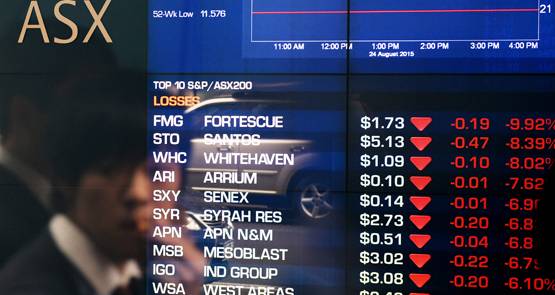
Market reality intrudes, again. Investors and many in the media and advice sectors of the markets have an infinite capacity to fool themselves. Take yesterday’s modest rebound, here and in Asian and European markets, because of what appeared to be stronger-than-expected trade figures for December from China. They were, but the surplus and smaller-than-expected fall in exports and imports was made to look a lot better by a splurge of opportunistic buying of oil, iron ore, copper, soybeans and other commodities in the month as world prices slid to multi-year lows. That was, in fact, the story from the Chinese trade account for 2015 as a whole. Without that opportunistic buying, the surplus (close to US$600 billion, yes, US$600 billion, say it slowly) could have been closer to US$800 billion (which is a very large sucking sound as money flows from the rest of the world into China).
The rebound (a weak dead cat bounce, to tell the truth) started running out of steam in late European, early US trading, and then the bears returned from their tea break to find some rich snacks, and down went Wall Street — in fact it slumped in the true sense of the word. The Dow lost more than 350 points, or over 2.2%, the S&P 500 fell 2.5% and Nasdaq dropped 3.4% (as investors realised that the tech and biotech and healthcare takeover boom and rorting that had gone on for the past two years was ending as the US elections approach). This time the usual suspect, oil prices, avoided blame by trading higher for the day, even though the gains faded the longer the day went on. Gold rose. — Glenn Dyer
A bloody day. Chinese investors got it right — instead of applauding the trade figures as many other markets did, they sold off local shares and the Shanghai index lost 2.4%.Yesterday’s 1.2%, 62-point jump in Australia was quickly wiped out and ASX fell sharply this morning. Other Asian markets followed, and 2016 will “celebrate” a second consecutive losing week for the year so far — a two from two record that no one wants. The sell-off on Wall Street though tells us that perhaps something more long lasting is underway. Investors abandoned usual staples like consumer-discretionary, financial and healthcare stocks (which have been good defensive investments in recent months). Utilities, the ultimate defensive sector, kept some gains. According to some analysts, the sell-off in the consumer stocks — retailers, media services, household durable goods, textiles and apparel firms, reflects growing expectations of a slowdown in the wider economy in coming months.
If selling in this sector (which includes the big tech stocks, Amazon, Netflix, Apple, Facebook etc that have buoyed the US market for the past few months) continues for much longer, then the Fed won’t be lifting interest rates any time soon, even this year. Facebook shares dropped 4%, Netflix was off 8.6%, Apple shed another 2.6% and is now well and truly under US$100 a share at US$96.11, Amazon tumbled 5.8% and 21st Century Fox dropped 2.4%. Shares in Walmart, the world’s biggest retailer, fell another 2.6% as well. Of all the rough days on Wall Street since the start of the year, this was the one with warning signs for the rest of the year. — Glenn Dyer
Opportunistic savings. Four commodities produced savings of more than US$160 billion alone in 2015, based on volumes and price changes last year compared with 2014. Take oil — imports hit a record 6.71 million barrels a day, up 9% (to 335.5 million tonnes in total), but the average price of China’s oil imports dropped 45% from 2014. Overall, the country spent US$134.5 billion on crude oil imports in 2015, an estimated US$114 billion cheaper than in 2014. Iron ore imports rose 2.2% to a record 852 million tonnes (and a record 96.27 million tonnes in December alone) and totalled US$57.6 billion by value — but on average the ore’s cost fell 39% from 2014. That 2.2% rise, by the way, was down sharply from the 13.8% jump reported in 2014 over 2013.
Copper imports were flat by quantity (down 0.3% overall) but the cost fell 17% per tone to total US$19.2 billion for the year. Coal imports fell 29.9% to 204.1 million tonnes last year, but the cost plunged nearly 22%, producing another big saving for Chinese importers and users. Some of the extra buying was to build reserves (such as oil), while copper, iron ore and oil imports rose in December ahead of the New Year break in early February (meaning the trade figures for this month should be a bit weaker) and to take advantage of the nasty slide in oil, iron ore and copper last month. But that opportunistic buying helped make the year look stronger than it was. A trade surplus around US$800 billion would have been a stunning but accurate reflection of the true extent of the country’s slowdown. No wonder Chinese manufacturing is wallowing in deep deflation — and has been for the past 46 months. — Glenn Dyer







Crikey is committed to hosting lively discussions. Help us keep the conversation useful, interesting and welcoming. We aim to publish comments quickly in the interest of promoting robust conversation, but we’re a small team and we deploy filters to protect against legal risk. Occasionally your comment may be held up while we review, but we’re working as fast as we can to keep the conversation rolling.
The Crikey comment section is members-only content. Please subscribe to leave a comment.
The Crikey comment section is members-only content. Please login to leave a comment.